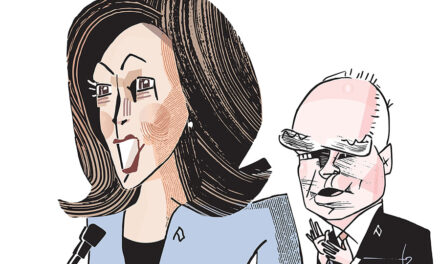
Three key takeaways from this story:
- Bus and T service could see the biggest cuts in 25 years. In 2007, service was reduced by 18%.
- Fares could increase. PRT last updated prices in 2022, setting a $2.75 flat fare for ConnectCard users.
- PRT is asking the state to hike its funding by $117 million — versus the governor’s proposed $40 million boost — and more in later years to avoid cuts and potentially being “out of business” in a few years.
Pittsburgh Regional Transit is set to propose its single largest service cut in decades to address a possible deficit of $100 million.
Fare increases would accompany widespread reductions — spanning bus routes, T light rail and shared-ride services — under the detailed proposal that PRT will release Thursday, spokesman Adam Brandolph confirmed to PublicSource.
While he wouldn’t share all the specifics, Brandolph said changes likely would take effect early in 2026 unless state lawmakers deliver a substantial funding increase for the fiscal year that begins July 1.
The service cutback would be the sharpest in at least 25 years, he said. That suggests a possible cut at least matching PRT’s 18% reduction in 2007.
Slashing service “is the opposite of what any transit agency wants to be doing,” Brandolph said. “But if we don’t start cutting service now, the deficits continue to grow — and not too long in the future, we would be out of business.”
To keep service intact, PRT is asking Harrisburg for $117 million more in the 2026 fiscal year, about triple the roughly $40 million boost that Gov. Josh Shapiro proposed in his 2025-26 budget rollout last month. Shapiro’s offer — around 13% more — wouldn’t be enough to stave off all cuts, although the agency had yet to determine its exact impact on service, Brandolph said.
An increase of $117 million would prevent any cuts and the $100 million shortfall PRT fears in 2026, he said. If allowed to materialize, that deficit could essentially lock in the large service cut and higher fares, according to the agency. The projection assumes about $6 million more in state funding, a 2% increase similar to the uptick PRT received for this year.
 The T runs down Broadway Avenue, in Beechview, on March 21, 2024. (Photo by Stephanie Strasburg/PublicSource)
The T runs down Broadway Avenue, in Beechview, on March 21, 2024. (Photo by Stephanie Strasburg/PublicSource)
The PRT reduction proposal also would kill the agency’s ongoing Bus Line Redesign project and could involve layoffs, he said. After committee meetings Thursday, PRT board members are expected to vote March 28 on a public comment period.
That comment period is likely to last into June as lawmakers negotiate the state budget. The General Assembly has a June 30 deadline to pass the spending plan, which provides more than half the agency’s operating money.
To state Sen. Judy Ward, a Blair County Republican, the $117 million PRT request is a tall ask. Pennsylvania’s multibillion-dollar structural deficit should be “the lens” for all state budget discussions, she said.
“Our budget doesn’t allow for a lot of additional spending,” said Ward, who chairs the Senate Transportation Committee. “When I talk with some of the transit groups, I’ve tried to stress to them that we need to right-size our agencies.”
But state Rep. Ed Neilson, D-Philadelphia, cautioned against holding back money.
“Not funding public transit is a mistake that Pennsylvania cannot afford to make,” said Neilson, majority chairman of the state House Transportation Committee. In a statement, he called PRT an economic driver that serves 220,000 daily riders, contributes $1 billion to the state economy and keeps 39,000 cars off the road.
Fewer riders mean more financial stress
Rising costs and diminished ridership since the COVID-19 pandemic are stressing PRT’s roughly $540 million operating budget, according to the agency. It’s powerless to trim many expenses that are locked in, like pay rates negotiated in collective bargaining, Brandolph said.
In recent years the agency has benefited from more than $502.5 million in federal pandemic-driven stimulus funding, but that funding is running dry.
Brandolph cited inflation and health care increases among the cost drivers. Meanwhile, ridership that cratered in the pandemic has rebounded but not to pre-COVID levels, denting revenue. The agency provided about 33.3 million rides in the last fiscal year, down from more than 60 million a year before the pandemic.
Further, state funding tagged for public transit hasn’t kept pace with local needs, Brandolph said. PRT’s state subsidies have climbed by $50 million since fiscal year 2019 while operating expenses are up $98 million, agency budgets show.
Already, PRT is digging into its reserve balance to plug an estimated $50 million deficit in 2025, Brandolph said. He estimated the reserve around $360 million — barely enough to last a few years if the agency can’t tame the deficit growth.
“That’s three years, and then PRT does not exist,” Brandolph said. “That’s not just the cliff. That is a death cliff.”
As part of its state request, the agency wants 2% annual increases over the next 10 years to maintain service. County contributions to the agency would grow, too, Brandolph said.
Since 2001, PRT has reduced service some 36% through several cuts, and lost half its ridership, according to the agency. Funding shortfalls were a primary factor through 2011, while pandemic-related issues and operator shortages drove reductions in recent years.
“Riders have already been suffering the impacts of less service — less frequent, at less hours of the day and going fewer places,” said Laura Chu Wiens, executive director of the Pittsburghers for Public Transit advocacy group. She said she “cannot imagine what the impacts would be if further cuts went through.”
The organization is a founding member of Transit for All PA, a statewide coalition seeking $540 million more in total transit funding in the next state budget. That would be enough to restore service to 2019 levels across the state, Chu Wiens said.
 Alexis Meier, right, a communications consultant, answers questions about proposed changes to Pittsburgh Regional Transit’s bus routes at the August Wilson African American Cultural Center on Nov. 14, in Downtown Pittsburgh. PRT held town halls and community pop-ups throughout Allegheny County to receive feedback on its proposed Bus Line Redesign, which could end if service cuts are implemented. (Photo by Nate Yonamine/PublicSource)
Alexis Meier, right, a communications consultant, answers questions about proposed changes to Pittsburgh Regional Transit’s bus routes at the August Wilson African American Cultural Center on Nov. 14, in Downtown Pittsburgh. PRT held town halls and community pop-ups throughout Allegheny County to receive feedback on its proposed Bus Line Redesign, which could end if service cuts are implemented. (Photo by Nate Yonamine/PublicSource)
Shapiro’s office didn’t immediately comment last week. His budget proposal would add nearly $293 million to public transit appropriations statewide by drawing more revenue from sales and use taxes.
PRT has done a better job than other transit agencies, including by raising fares, Ward said. The agency updated prices in 2022, when it set a $2.75 flat fare for riders using PRT’s ConnectCard. The ConnectCard price, up 25 cents from the prior single-trip rate, now includes unlimited transfers within a three-hour window.
Ward suggested PRT may need another fare increase and should look for efficiencies.
“It’s a large state. It requires roads and bridges be maintained — and the safety of those — and that has to be balanced with public transit dollars as well,” she said. The balancing act means “everyone needs to be efficient” and “accountable for their dollars.”
“In PRT’s case, too, they may need to look at why their ridership is down,” Ward added, calling that “probably the $1 million question. That would be helpful in determining how they proceed.”
Brandolph said libraries, police and parks aren’t denied funding when people read less, crime falls and park visits drop off. “Access to public transit is a public service that should be treated — and funded — similarly,” he said.
Nationally, transit ridership in September 2023 was at 74% of September 2019 levels, according to a Federal Transit Administration report last August. It cites factors including the rise of hybrid and remote work, which scrambled commuting habits.
Cuts could ‘take away the progress’
For PRT, state Rep. Lindsay Powell, D-Lawrenceville, said her goal is to avoid “massive service disruption” and keep riders from upending their routines. Her district includes Etna, Millvale, Reserve, Shaler and parts of Pittsburgh fronting the Allegheny River.
She didn’t own a car before her 2023 election, relying on PRT for work and grocery shopping. Public transit isn’t a luxury but a necessity, she said.
“Public transit has been historically disinvested and not seen as a priority,” Powell said. “And now we’re facing a dangerous reality where we could be without life-saving, life-connecting service.”
To those who argue PRT can raise fares, she says the agency already has high prices compared with transit in other cities. In a survey conducted in fiscal year 2023, about half of PRT riders had household income of $24,900 or less — and 67% had no access to a vehicle.
Major cuts to public transit would be “devastating” for riders who depend on the service, Powell said. The PRT system already “has a long way to go to make sure we’re meeting the needs of the people,” she said.
The now-jeopardized Bus Line Redesign project has been evaluating how people use the system since the pandemic, developing a draft reorganization to “better serve and connect riders to places they want and need to go,” PRT has said. The agency received thousands of comments on a draft proposal, Brandolph noted.
“For riders who may not feel like their transit system is the best reflection of their needs, additional cuts are going to take away the progress PRT is hoping to make,” Powell said.
Adam Smeltz a freelance reporter and former staff writer for the Pittsburgh Post-Gazette and the Pittsburgh Tribune-Review. He can be reached at asmeltz@gmail.com.
This story was fact-checked by Rich Lord.
Your gift will keep stories like this coming.
Have you learned something new today? Consider supporting our work with a donation.
We take pride in serving our community by delivering accurate, timely, and impactful journalism without paywalls, but with rising costs for the resources needed to produce our top-quality journalism, every reader contribution matters. It takes a lot of resources to produce this work, from compensating our staff, to the technology that brings it to you, to fact-checking every line, and much more.
Your donation to our nonprofit newsroom helps ensure that everyone in Allegheny County can stay informed about the decisions and events that impact their lives. Thank you for your support!
MOST READ PUBLICSOURCE STORIES
Republish our articles for free, online or in print, under a Creative Commons license.




